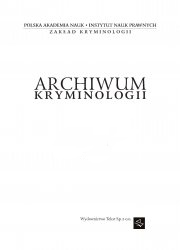PRAWO DO PRAKTYK RELIGIJNYCH OSÓB OSADZONYCH W ARESZCIE ŚLEDCZYM I ODBYWAJĄCYCH KARĘ POZBAWIENIA WOLNOŚCI W TEORII I PRAKTYCE PENITENCJARNEJ
The Right of Inmates of Remand Prisons and Penitentiary Facilities to Religious Observance - In Penitentiary Theory and Practice
Author(s): Olga Sitarz, Anna Jaworska-WielochSubject(s): Law, Constitution, Jurisprudence, Criminal Law
Published by: Instytut Nauk Prawnych PAN
Keywords: kara pozbawienia wolności;osadzeni;prawo do praktyk religijnych; tymczasowe aresztowanie; kryminologia;
Summary/Abstract: The article discusses the right to religious observance as one possible form of exercising one’s freedom of conscience for persons in temporary detention or serving a sentence of (unconditional) imprisonment. Detention involves a range of (usually justified) restrictions and deprivations, some of which apply to the sphere of religious practices. We must not forget that freedom of conscience and religion is not only internal to a person, but also relates to his or her actions in their semi-private and public space and, as such, must be regulated, particularly in conditions of detention. Importantly, the article does not focus on the influence of religious life on the rehabilitation of inmates but on whether their right to religious freedom is respected. The aim was not to find out whether inmates needed religious practices and services in prison, but to assert that they had a right to them, while the state had a duty to respect that right.We departed from the assumption that religious practices were a matter of public or private cult and included performing certain actions dictated or forbidden by the laws of a given religious community. The question was to what extent these practices were subjected to limitation, which practices were concerned and to what extent the observed limitations were justified. The answer drew on existing legal provisions and on the subjective feelings of inmates themselves. It should be recalled that in 1991, the Polish Ombudsman determined that the right of inmates to practice Catholicism was essentially ensured and properly implemented in prisons. The only shortcoming, as judged at the time, was the lack of a sufficiently high-level normative act regulating all matters pertaining to religious practice in detention in a comprehensive way. It seemed necessary to check whether these findings were still valid. Thus the first part of the article provides an overview of the existing legal provisions defining the scope of religious practices that can be undertaken by inmates, including international regulations, the Polish constitution, acts of law and other relevant regulations. Different groups of inmates were examined, including those in temporary detention, those serving sentences and considered particularly dangerous as well as those subjected to the disciplinary measure of being placed in an isolation cell for a period of up to 28 days. We found that not all restrictions on the exercise of religious freedom in prison, as provided for under the Polish law, were justified. Our assessment of the said restrictions, both when it came to law making and application, took into account the goals and purpose of imprisonment and temporary detention in light of the constitutional criterion of proportionality. In the second part, we present the findings of a survey conducted in two penitentiary facilities among inmates declaring themselves Roman Catholic. The aim was to find out how the inmates viewed their rights when it came to religious practices, to what extent those practices were available to them and whether they felt any deficits in this area. At the general level, we found that the inmates declared significant activity in the religious area and rarely attributed obstacles to the exercise of religious rights to legal provisions or the rules in a given penitentiary facility. The unavailability of particular religious practices was also reported to be low. There were more answers indicating lack of permission to take part in Church ceremonies outside the prison (for example the funeral of a loved one). This is probably the weakest area when it comes to ensuring the exercise of inmates’ religious freedoms. Our analysis of the legal framework and the survey carried out in penitentiary facilities allowed us to formulate certain tentative conclusions (including de lege ferenda). The normative provisions do not impose many legal limitations on inmates’ access to religious practices and services. Yet respecting the right to freedom of religion is not only about not creating unnecessary barriers; it also consists in defining a minimum set of rights conferred on each inmate, on which they can call the prison authorities to account if need be. It seems difficult to accept that the state should define inmates’ minimum calorie intake or the length of walks and frequency of bathing, while at the same time leaving the decision concerning the number of religious
Journal: Archiwum Kryminologii
- Issue Year: 2017
- Issue No: XXXIX
- Page Range: 117-148
- Page Count: 32
- Language: Polish

